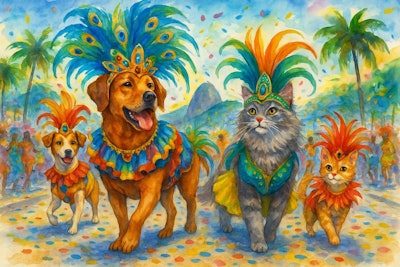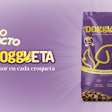
Brazil has one of the largest pet populations in the world. There are over 160 million pets – including dogs, cats, birds, reptiles, fish, and small amphibians – that are considered members of Brazilian families, according to the latest survey by the Brazilian Association of Pet Product Industries (Abinpet) and the Instituto Pet Brasil (IPB). This also means that more and more households are including pet food and other pet supplies in their monthly shopping.
Read this article in Portuguese
Mais brasileiros compram ração para pets, mas crescimento do setor ainda é lento
A study by Kantar shows that over 7.8 million Brazilian households started buying dog or cat food in 2024, totaling 62% of Brazilian families including the category in their shopping carts. This reflects a 12-percentage-point growth in the penetration of the Brazilian pet food industry in the last four years. However, experts point out that this growth is still slow, given the potential of the Brazilian market.
“Brazil is the third-largest pet market in the world, behind only the United States and China. But the Americans have a much larger market share than ours,” says José Edson Galvão de França, executive president of Abinpet and a member of the IPB Advisory Council. According to Statista, the market penetration of pet food in the United States is 27.9% in 2025.
According to Galvão de França, factors such as inflation, exchange rate volatility – which influences the price of commodities necessary for pet food production –logistical costs, new consumption trends, and taxation are negative influences in this scenario. The latter being the one that most affects market gain.
“In the United States, the greater purchasing power of the population and the consumption culture explain some of the higher penetration. But lower taxes carry a lot of weight in this scenario,” he reports. In the US, the tax burden on pet food is around 7%. In Brazil, taxes can represent 50% of the final product price.
Pet sector growth in 2024 was below expectations
The Brazilian pet sector closed the year 2024 with a total revenue of BRL 75.4 billion (US$ 12.7 billion), below projections that estimated exceeding BRL 77 billion (US$ 13 billion). The sale of industrialized pet food accounted for 54.1% of the sector's revenue, ending the year with BRL 40.8 billion (US$ 6.8 billion).
The data, released in March by IPB in conjunction with Abinpet, indicate a total growth of 9.6% compared to 2023, not reaching double digits for the first time since 2019, before the impacts of the Covid-19 pandemic. “The pet sector remains solid, but the 2024 results reflect the economic challenges and the weight of high taxation on the sector's products and services,” comments Caio Villela, president of IPB.
Regarding access channels, small and medium-sized pet shops remain responsible for almost half of all retail movement. By the end of 2024, they had moved BRL 36.6 billion (US$ 6.1 billion). In second place are veterinary clinics and hospitals, which represent about 18% of revenue (BRL 13.4 billion / US$ 2.2 billion). Completing the top three, mega pet store chains have a 9.3% share, with a revenue of BRL 7 billion (US$ 1.1 billion).
In e-commerce, virtual pet shops account for 40.6% of revenue, with R$ 2.3 billion (US$ 388.5 million), followed by the online stores of mega stores, with BRL 1.5 billion (US$ 253.3 million) (26.8%), and the online stores of small and medium-sized pet shops, with BRL 1.2 billion (US$ 202.7 million) (21.5%). According to the Kantar study, apps are highlighted for accessing virtual stores, jumping from 32% contribution to 39% in 2024. Still, WhatsApp remains a favorite among Brazilians, capturing 45% of requests. “Despite the increasing relevance of digital, this more modest growth is a concern. The consumer is more discerning, which reinforces the need for efficient strategies to maintain competitiveness,” declares Vilela.
Impacts of taxation on the pet food market
The entities point to taxation as the main factor for the 2024 results. In addition to the modest growth, high taxes also explain the historical drop in pet food production.
In 2024, 4 million tons of pet food were produced in Brazil, a reduction of 0.6% compared to 2023. According to the entities, this is the first time in the historical series that a drop has been recorded in the segment. “We estimate that, for 2025, if the tax scenario and the exchange rate remain as they are, the drop in production will be greater, reaching almost 4%,” predicts the executive president of Abinpet.
In Brazil, complete food for pets is taxed as a non-essential product, even though three out of five households have a pet. “If there were a tax adjustment, pet sector prices would be reduced, and demand would be expanded, benefiting millions of Brazilian families,” emphasizes Galvão de França.
According to surveys commissioned by the entities, a 60% tax exemption could boost industrial production to up to 9 million tons annually in potential, and a general increase of 210%, considering the entire supply of products and services, in tax collection. Furthermore, the president of Abinpet also argues that the exemption would increase families' access to essential pet products, potentially reducing animal abandonment rates. "Including the pet sector in reduced tax rates is a matter of tax justice and public health," says Galvão de França.

















